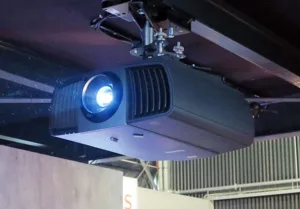BenQ was showing several interesting projectors at ISE and perhaps the most interesting was the X12000 projector. This was a single panel DLP UHD (3840 x 2160) pixel-shift projector with 2200 lumens output and 50,000:1 dynamic contrast. The projector is targeted at home cinema applications. The interesting thing about it was it was powered not by a laser-phosphor light source but a Philips ColorSpark source. According to BenQ, this gives the X12000 a full DCI-P3 cinema color gamut. A similar 2200 lumen projector was also shown, the W11000, that was powered by a UHP lamp and had Rec. 709 colorimetry and THX Certification. According to BenQ, the W11000 is the world’s first 4K/UHD projector certified by THX. Other features of both projectors include horizontal and vertical lens shift and a zoom lens, both useful when trying to install a projector in a home cinema environment. With ColorSpark LED technology, the X12000 projector also has instant on/off.
 Images produced by the BenQ W11000 (left) and the X12000 projectors were shown side-by-side at ISE.
Images produced by the BenQ W11000 (left) and the X12000 projectors were shown side-by-side at ISE.
The images shown by the two projectors were both outstanding and the photo doesn’t really do them justice. The image produced by the X12000 appeared to have slightly more saturated colors than the W11000, as could be expected from its larger color gamut. Unfortunately, however, little or no content is released to the consumer that has been color graded for the cinema P3 color gamut. This would not be a hard thing for the studios to do, since that is the color gamut used by all content for showing in movie houses. It should be relatively simple to release P3 color gamut to the public by fitting it inside a Rec. 2020 UHD encoding system.
According to the BenQ rep, the X12000 will be priced at about €8000 and the X11000 will be priced at about €6000.
Another new projector shown by BenQ was the LK970. This is also a 4K UHD (3840 x 2160) resolution single panel DLP projector that uses pixel shift to achieve the full resolution. It has 5000 lumens output, 50,000:1 dynamic contrast and is powered by a laser-phosphor light source, called BlueCore by BenQ. In the Blue Core system, a bank of blue lasers illuminates a yellow phosphor wheel, which has a clear gap to transmit the blue light. A second synchronized color wheel breaks the yellow light from the phosphor wheel into red and green light. The system delivers color sequential red, green and blue light to the DLP imager.
This is actually the third projector of nearly identical design produced by BenQ, according to the rep at ISE. The other two have lamp and LED (but not ColorSpark) illumination, with 4000 and 2000 lumens output respectively.
Ceiling mounted LK970 at the BenQ booth at ISE
The LK970 projector is targeted at business applications, including projected digital signage. The price has not yet been formally set but the BenQ rep said it will be about €10,000. The projector will be introduced later this year.
BenQ was also showing another business projector, the LU9715, which has been shipping since last July 2016 at a price of $16,999. This is also a single panel DLP projector based on Blue Core light source. It has 8000 lumens output and WUXGA resolution (1920 x 1200). –Matthew Brennesholtz
BenQ also had a range of flat panels at the show. The RP750K is a newish 75″ FullHD interactive display that was also shown at the BETT event. It uses BenQ’s EZWrite 4.0 software and an NFC Pen. The software has new features including letter and shape recognition and annotated content can be shared. The board allows simple connections using NFC or QR codes. The display has Android integrated as standard, but can also accept a ‘blade style’ slot in PC module (not OPS). Features include a germ-resistant AG surface. There were other interactive and UltraHD digital signage displays, but all were existing products that we have previously reported.
The PL552 and PL490 are narrow bezel video wall monitors with 3.5mm (combined) bezels and FullHD resolution. Features include DisplayPort output to allow UltraHD support on 2 x 2 arrays. The displays have colour calibration software support for matching. Response time is 12ms, contrast is 1,400:1 and brightness is 500 cd/m2. The monitors are rated for 24/7 use.
Also on display were the BenQ colour-critical monitors including the existing PV270. (BR)

